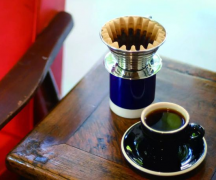Indian Coffee: monsoon Coffee with Ocean Flavor
When I drank Indian coffee for the first time, a friend told me that it was a kind of coffee with "ocean flavor" because Indian coffee beans were dried by salty sea breeze. Five or six people tasted the coffee together. After a sip, they closed their eyes and looked intoxicated. When they opened their eyes, they said to each other with sly smiles-- it really is. It's imaginary, not drinking.
But in fact, Indian coffee is famous for the Indian Ocean "ocean monsoon".
Coffee cultivation on the Indian peninsula originated from their colonists, the British. As early as the 17th and early 18th centuries, the English were not as addicted to tea as they are now, they liked coffee. It is naturally the best choice to grow the coffee they need in colonies with suitable soil and water climate. The coffee growing industry in India has grown rapidly under the demand and promotion of the British. Although a large number of coffee plantations were converted to tea trees after experiencing coffee rust and the British habit of drinking tea, coffee still grows on the Indian peninsula. After India got rid of the British colony, the coffee growing industry also developed vigorously.
Before the invention of steamships, coffee was transported by sailboats from India to England, often for months at sea. Coffee beans have been adrift in the ocean for a long time. Due to the high humidity, the coffee beans originally turquoise turned into a wonderful yellow and their taste changed when they arrived in Europe. Ships later became the main means of transport, but short trips made Indian coffee, like Java coffee in Indonesia, changed people's habitual taste, so that a "monsoon processing" method had to be invented to produce this effect in the past.
In May and June every year, there is a monsoon in southwestern India. During the monsoon season, coffee beans are spread out in special houses with ventilation on all sides, allowing the extremely high humidity monsoon to comb the coffee beans. About a week later, the coffee beans were packed in loosely packed bags so that the monsoon could blow through the bags. These bags are packed once a week, and after about 7 weeks, the coffee beans change color and taste. Finally, the coffee beans are hand-selected, those that are not affected by the monsoon are picked out and officially bagged for export. October to February of the following year is a good time to make "monsoon coffee".
Coffee in India is mainly Arabica coffee, Robusta (Robst) was introduced in the late 19th century after the rust disaster, also accounted for a certain proportion. India exports coffee beans, roasted beans and instant coffee, of which only Elaraby beans that have been washed will receive special monsoon treatment. After the monsoon baptism, the Indian coffee is smooth and delicious, full-bodied, but has a strange spicy taste. Some people say that Indian monsoon beans and Indonesian aged beans have similar tastes, probably because although they are treated differently, the principles are the same.

Important Notice :
前街咖啡 FrontStreet Coffee has moved to new addredd:
FrontStreet Coffee Address: 315,Donghua East Road,GuangZhou
Tel:020 38364473
- Prev

Costa Rican coffee bean flavor description taste treatment grinding scale varieties
All coffee grows in the tropics, in fact, altitude has no direct effect on coffee, but altitude can affect the growth, development and quality of coffee through the redistribution of meteorological elements (temperature, light, heat, wind speed, rainfall, etc.). The tropical region between the Tropic of Cancer and the Tropic of Cancer produces the world's truly high-quality Arabica coffee. Central and South America, South Asia and
- Next

Irrelevant coffee
Irrelevant coffee is a boutique cafe with high private density, but because it is in the alley, it is inevitable to get lost when you go there for the first time. In the courtyard of a villa, the shop is designed as an open and literary shop with a container, while in front of the shop is an independent private courtyard with whirling fruit trees. It's really pleasant to have a cup of coffee in such an impeccable environment. From the day
Related
- What documents do you need to go through to open a coffee shop? coffee shop coffee shop certificate processing process
- How to purchase Coffee beans in small Cafe how to choose a suitable supplier for domestic Coffee supply Company
- How to drink Starbucks Fragrance White Coffee? how to make Australian White Coffee? what Italian coffee beans are recommended?
- The Story of Flora Coffee: the name of Flora Coffee Bean and the implication of the Flowers on Florna Coffee
- How much does a cup of coffee cost? How much is the profit of a cup of coffee? What is the profit of the coffee shop in a year?
- Yunnan small Coffee, known as "fragrant Coffee", introduces the characteristics of Alpine Arabica Coffee producing areas in Yunnan, China
- 2023 latest Starbucks full menu price list how much is a cup of Starbucks coffee what is better to drink the most popular hot and cold drinks recommended
- Starbucks different kinds of Coffee Price list Starbucks menu 2023 Top Ten Best drinks in Starbucks
- Starbucks Spring praise Comprehensive matching Coffee Bean theme Story Packaging implication and taste description
- The cost of a cup of coffee latte American coffee cost price and selling price

